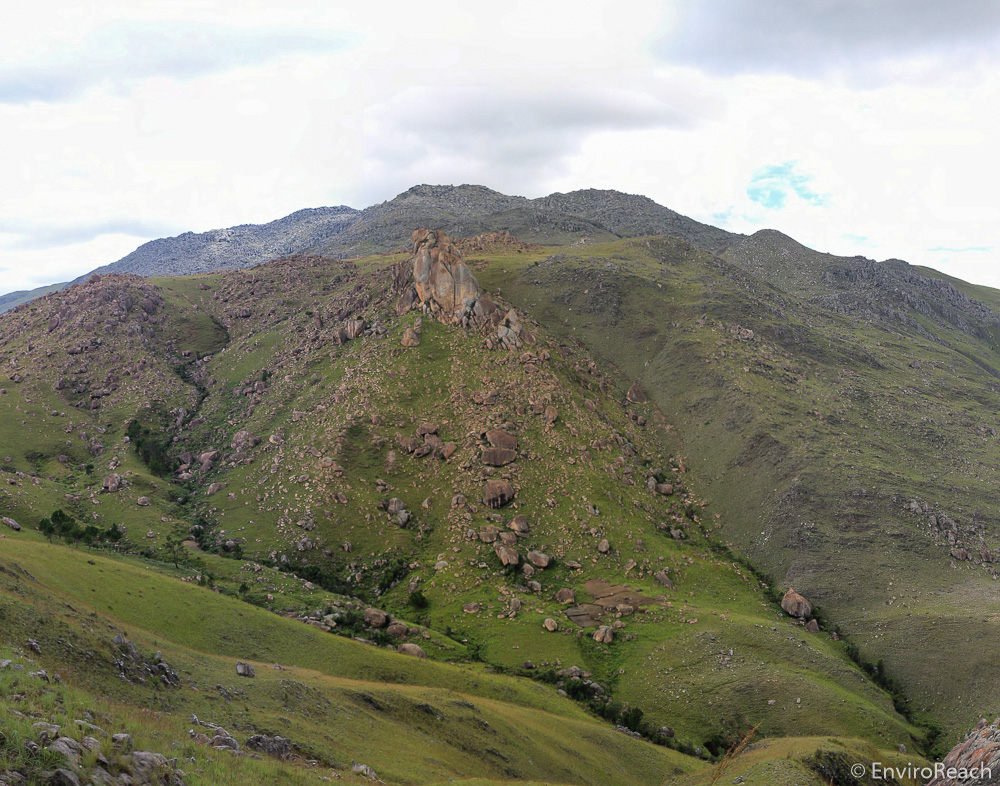The rate of deforestation and species extinction are increasing worldwide, and substantial efforts are being made to establish new protected areas (NPAs), build local environmental organizations and improve management of new preserves.
A recent study published in mongabay.com’s open-access journal, Tropical Conservation Science, discusses how sustainable conservation management strategies are being carefully planned for a newly established and ecologically rich protected area on the Ibity Massif in the central highlands of Madagascar.
Madagascar’s highlands have a long history of human occupation and disturbance dating back 2000 years, and much natural vegetation is severely fragmented. Natural vegetation has been replaced by human influenced grasslands and agricultural areas.
The local pockets of natural vegetation that remain constitute centers of high diversity, and the conservation of these areas are of high importance. One such region is Madagascar’s Ibity Massif.

A landscape view of part of the Ibity Massif. Photo credit: EnviroReach.
The study authors write that Ibity possesses “unique plant communities that are home to many species, both herbaceous and woody, endemic to Madagascar and in some cases to the Ibity region or the massif itself.” The preserve was granted temporary protection in December 2008, and is expected to get permanent protection in mid-2015.
The conservation of natural ecosystems in present-day Madagascar can only be achieved by reaching a sustainable balance with local human needs, say the authors. Conservation strategies must recognize the need to manage the entire landscape, including the activities of local people who are dependent on local natural resources.
The Madagascar Code of Protected Areas is closely aligned with this inclusive model, and intended to protect biodiversity and ecological habitats, facilitate research, promote ecotourism, and contribute to the sustainable development of the populations living in proximity to protected areas, while contributing to economic development.
The study authors describe the “diagnostic process” which they used at Ibity: (1) to disseminate data gathered to inform establishment of the NPA, and (2) to summarize the initial state of the massif environment prior to the implementation of a management plan to assess the NPA’s effectiveness.
The researchers conducted a suite of studies to determine the initial state of the Ibity Massif environment. These baseline studies evaluated: biological characteristics (flora and fauna inventory mapping), vegetation cover trends and dynamics over space and time, human activities and impacts on vegetation over time, the impact of fire on plant communities and plant ecology, and human demands on the environment and its capacity to satisfy those needs.
This diagnostic process resulted in the creation of four conservation objectives, including the restoration of gallery forests on the massif, restoration of tapia tree woodlands, the reduction of the risk of extinction for threatened species, and management of exotic invasive species inside the NPA.
 Women working in a terraced rice field in Madagascar. Photo by Rhett Butler.
Women working in a terraced rice field in Madagascar. Photo by Rhett Butler.
In Africa, previous studies have shown that conservation actions taken without consideration of the social and environmental effects on the local population (known as an exclusive model) tend to increase poverty in surrounding rural communities. Best practices show that an inclusive model – that preserves and maintains the current landscape and its biodiversity, as well as traditional interactions with the local population – is a much more appropriate management solution.
At Ibity, a participatory process brought together all key stakeholders for management tasks, and involved local authorities, the local population, the staff of the NGO initiative promoter (the Missouri Botanic Garden), various management boards, police, local NGOs, the local Vak Mine service, tourism NGOs, representatives from three municipalities, and local development operators.
These partners promote eco-tourism; apply local community roles (known as dina), including early fire detection and the prevention of mining and exploitation of woody plants inside the NPA; facilitate development in municipalities encircling the preserve; support responsible legal mining outside the NPA; and facilitate research.
The authors of the paper explain how the formation of the Ibity NPA was the result of a careful inventory, with research focus on land uses and their impact, along with extensive discussions and negotiations between all key stakeholders.
They conclude that “close cooperation among the project managers, the local population and the relevant authorities must now be maintained in order to minimize and manage the risk of possible conflicts between the legitimate needs of the local population and the goal of conserving biodiversity, and to ensure that local stakeholders benefit directly from conservation activities while continuing to exercise their rights to use the area’s natural resources sustainably.”
Citation:
- Alvarado, S. T., Buisson, E., Carrière, S. M., Rabarison, H., Rajeriarison, C., Andrianjafy, M., Randriatsivery, F. M., Rasoafaranaivo, M. H., Raharimampionona, J., Lowry II, P. P., and Birkinshaw, C. (2015) Achieving sustainable conservation in Madagascar: The case of the newly established Ibity Mountain Protected Area. Tropical Conservation Science Vol.8 (2): 367-395.